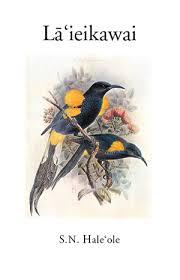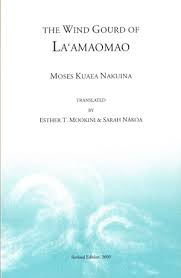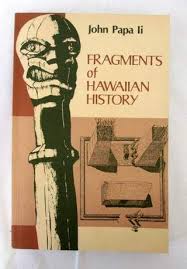I donʻt include many recent books – only two from the 21st century – because their legacy has yet to be determined.
- Samuel Kamakau, Ruling Chiefs of Hawai’i – The Sheer volume of history in this tome makes most other work pale in comparison. Kamakau also issues stern warnings, even to the King, of excessive Western influence.
- S.N. Haleole, Laieikawai – Translator Martha Beckwith (author of the definitive book The Kumulipo) had this to say of Haleʻoleʻs book:
La‘ieikawai is a Hawaiian romance which recounts the wooing of a native chiefess of high rank and her final deification among the gods. The story was handed down orally from ancient times in the form of a ka‘ao, a narrative rehearsed in prose interspersed with song, in which form old tales are still recited by Hawaiian storytellers. It was put into writing by a native Hawaiian, S.N. Hale‘ole, who hoped thus to awaken in his countrymen an interest in genuine native storytelling based upon the folklore of their race and preserving its ancient customs – already fast disappearing since Cook’s rediscovery of the group in 1778 opened the way to foreign influence – and by this means to inspire in them old ideals of racial glory.Hale‘ole was born about the time of the death of Kamehameha I, a year or two before the arrival of the first American missionaries and the establishment of the Protestant mission in Hawai‘i. In 1834 he entered the mission school at Lahainaluna, Maui, where his interest in the ancient history of his people was stimulated and trained under the teaching of Lorrin Andrews, compiler of the Hawaiian dictionary, published in 1865, and Sheldon Dibble, under whose direction David Malo prepared his collection of “Hawaiian Antiquities,” and whose “History of the Sandwich Islands” (1843) is an authentic source for the early history of the mission. Such early Hawaiian writers as Malo, Kamakau, and John Ii were among Hale‘ole’s fellow students. After leaving school he became first a teacher, then an editor. In the early sixties he brought out La‘ieikawai, first as a serial in the Hawaiian newspaper, the “Kuokoa,” then, in 1863, in book form.
-
Moses Nakuina, Wind Gourd of La’amamao – UH Mānoa Professor Niklaus Schweitzer says:
The Wind Gourd of La ‘amaomao enables the reader to understand important values of pre-contact Hawai’i, such as the role played by the ideal attendant of an ali’i, which was characterized by a caring attitude both towards the lord as well as towards the maka’ainana, the common. ers, and which included expertise in a variety of useful skills, such as canoe carving, canoe sailing, fishing, bird catching, and a host of others. Generosity, kindness, loyalty, honesty, justice, filial piety, patience, are values of old Hawai’i emphasized in this saga which was considered sig.nificant enough to be published in several versions in Hawaiian and English, beginning with Samuel M. Kamakau’s serial, Moolelo no Pakaa (1869-1871), in the newspapers Ke Au Okoa and Ka Nupepa Kuokoa. The present version by Moses K. Nakuina is based on Kamakau but draws from a number of other sources as well.
-
Davida Malo, Hawaiian Antiquities/Mooolelo Hawaii – While some might put this first, as its importance is unquestionable, itʻs more of an anthropology than a history, as Malo seems to dissect and critique Hawaiian culture. He had the “zeal of the newly converted” as Emerson put it, and it shows. Itʻs still crucial for all scholars of Hawaiian studies.
-
Lili’uokalani, Hawai’i’s Story – A first-hand account of the most important event in Hawaiian history, from its most aggrieved victim – the Queen shows tact and grace beyond what can be expected.
-
Noenoe Silva, Aloha Betrayed – the first very theoretical book on Hawaiian history and politics, Silva invokes Spivakʻs question “Can the subaltern [the oppressed underclasses] speak?” and goes beyond it to articulate the ways in which they do.
-
John Papa I’i, Fragments of Hawaiian History –
Iʻi was the patrician who chided the upstart Kamakau, and told us in incredible detail how it really was in the time of Kamehameha II.
-
Mary Kawena Pukui, Olelo Noeau – Of all Pukui’s work, this is perhaps the most valuable, because the meanings – the kaona – of Hawaiian proverbs may have been lost without it.
-
Joseph Poepoe/Steven Desha, Mooolelo no Kamehameha/Kekuhaupio – So apparently Desha plagiarized (if such a concept exists in Hawaiian thought) from Poepoe, whose work is yet to appear in published form. It is still a valuable supplement to Kamakauʻs account of Kamehamehaʻs conquests. The Kamehameha Schools Press English translation is called Kamehameha and His Warrior Kekūhaupiʻo.
-
Haunani-Kay Trask, From a Native Daughter –
A masterpiece according to Alice Walker, author of The Color Purple, a mere collection of speeches according to others; its impact cannot be denied. It galvanized the Hawaiian movement in a way no other book has.
-
Lilikala Kame’eleihiwa, Native Land and Foreign Desires – While my own research opposes some of her conclusions on the Māhele, her work on Hawaiian metaphors will stand as a lasting contribution to Hawaiian perspective.
-
Keanu Sai, Ua Mau ke Ea: Sovereignty Endures –
It’s a bit hard to find, but Sai’s contribution to revising Hawaiian history cannot be denied. This is also a useful primer on occupation and the legal aspects of Hawaiʻi’s history and status today.
-
Pi’ilani, Kaluaikoolau – The heartrending story of Piʻilani and Koʻolau has been recognized by W.S. Merwin and many others. Gary Kubota’s play is only the most recent tribute to this moving account of a familyʻs resistance to the “Pu Ki” [PG: Provisional Government].
-
John Dominis Holt, Waimea Summer – Holt seemed often to feel uncomfortable in his own skin, with frequent references (including in The Sharks of Kawela Bay) to his fair skin and blond hair, despite being nearly half Hawaiian. But this may have been what allowed him to write about the hapa-haole and Hawaiian experience with such skill; probably the only book to include pidgin, Hawaiian language and Faust.







Dear Umi:
Thanks for all the information which you regularly post concerning Hawaiian history. I do have one question which you may have an opinion about. In the introduction to La’iekawai, Martha Beckwith states that John I’i was among Haleole’s fellow students (see #2 in your list). My question is whether or not John Papa I’i studied at Lahainaluna. Marie Alohalani Brown who is writing a biography of I’i has emailed me and told me that she has seen many references to the possibility that he might have been a student at Lahainaluna but she doubts it. She thought that he was too busy to have the time to study there. I have found references by Rubellie Johnson (1-Native Hawaiian Study Commission, 2-Essays in Hawaiian Literature), Julie Stewart Williams (“A Kingdom of Learning”), Sally Engle Merry (Colonizing Hawaii) stating that I’i was a student at Lahainaluna and one reference by Marshall Sahlins (Captain Cook at Hawaii) stating that I’i was not Lahainaluna trained. If you have an opinion on this or know where I might be able to get more information, it would be most helpful.
Mahalo, Ralph Yanagawa
Sent from my iPad
>
LikeLike
Mahalo Ralph,
I would think that he was too old to go to Lahainaluna, even though they were older students. And probably too busy, like you said. One thought I had was that thereʻs another Iʻi, Daniel Iʻi, and maybe he went to Lahainaluna. I did have a list of Lahainaluna students from one year – Iʻll try to dig it up. Itʻs interesting you ask, because Iʻve been trying to figure out the same thing with my great-great grandfather Keliʻimakekau (who, ironically, is my cousinʻs namesake, who disagrees with my number 12 – see comment below) – whether he went to Lahainaluna. His son Ramon Hoe Makekau is on the cover of the newest Hawaiian Journal of History, in a piece by Ron Williams. endless connections…
LikeLike
#12 does not count because by write its not a book, its a compilation of historical documents “other peoples work” and government records with a brief point from a dissertation on a political theory.
LikeLike
That maybe true however, he has compiled all the information between a front & back cover which by definition is a book that can be read. Otherwise one would have to research for many hours to grasp all the that information.
LikeLike
Iʻm pretty sure thatʻs not right – he had a contract originally from UH Press, which pretty much means itʻs a book.
LikeLike
Aloha e Umi;
Thank you for this post. All but one of your picks are in my library. I love so many books for different reasons, that it is impossible to select all-time favorites. When I am researching a specific lineage, practice or land diviision, the book that holds the answer is my best friend that day!
I care not if it is a compilation, manuscript, informant testimony, narrative or listing – does it share and preserve some truth of an oral tradition, belief or practice? Hawaiian culture seems to be hidden in the language, places and legend. Therefore, primary sources in ʻOlelo Hawaii, spending time in wahi pana and replicating the work or craft is pretty much required to understand what historical resources are talking about.
The more I study, the more I realize I do not know. But thatʻs okay — history is a team sport. The work of other dedicated researchers of past generations who took the effort to write down what they discovered is a priceless treasure. What a pity it would be if Hokuleʻa hoʻokele had to use all Latin, Greek or Micronesian names for the stars because Kawena and Auntie Rubellite Johnson had not documented all the Hawaiian names of for stars and constellations?
An old copy of the Hawaiian Dictionary with the separate secton on astromomy is one of my top picks. Here are a few more:
Arts and Crafts of Hawaii by Te Rangi Hiroa
Kahuna Laʻau Lapaʻau and Na Plu Kahiko by June Gutmanis
A Dictionary of Hawaiian Legal Land Terms – Paul Nahoa Lucas
Traditions of Hawaii – Keperino
The History of Kanalu – Benjamin K, Namakaokeahi (translation by Chun)
Book of Omens e pili ana na hale – D.K. Waialeale
Sites of Maui – Elspeth Sterling
Nana i Ke Kumu – Pukui, Haertig and Lee
Native Planters – Handy, Handy and Pukui
ʻOlelo Noʻeau – Pukui
Ancient History of the Hawaiian People – Fornander
Ku Kanaka – George Huʻeu Sanford Kanahele
Buke Kakau Paʻa no ka mahele ʻaina -Miriam Kekuanaoa
LikeLike
E Umi, mahalo nui loa iā ʻoe for this wonderful reading list recommendation. I have read most of them and found the reading markedly increased my knowledge and understanding of Hawaiian culture; my outrage at the manner in which Americans (U.S. citizens generally) have perceived and dealt with Hawaiians and Hawaiʻi nei; and my sympathy for the growing Hawaiian Sovereignty and Independence movement.
LikeLike
Responding to Katherine Kamaʻemaʻe Smithʻs comment that was not posted previous to entering my comment above, I have appreciated certain books on Hawaiian spirituality that Iʻve read over five decades. Offhand I recall “Tales of the Night Rainbow”, Kristen Zambukaʻs several books among which are “The Keepers of the Earth” and “Secret Blossoms”, and June Gutmanisʻ “Kahuna Laʻau Lapaʻau”. There are others that broadened my understanding that I unfortunately cannot recall now.
LikeLike
I nominate “The Story of Ko’olau the Leper” as told by his wife Piilani and translated by Frances Frazier. Greatest love story ever told!
LikeLiked by 1 person
John, I was so moved by this story, I wrote about it (in a very academic format) for Kamehamehaʻs academic journal Hulili: http://www.ksbe.edu/_assets/spi/hulili/hulili_vol_4/3_Pono_and_the_Koru.pdf
LikeLike
Thanks for much for your article Umi. Much appreciated
.
LikeLike
Mahalo nui loa for all of these wonderful recommendations. My Hawaiiana and Polynesian cultures library is extensive but I am missing some of these recommended books, which I shall promptly add to my library in support of my journey of study and sharing manao in the appropriate manner in our Halau.
LikeLiked by 1 person
I’m looking for a book that’s a compilation of stories written by a Hawaiian fisherman for the Hawaiian Newspaper. it has a lot of stories about fishing and one about the author and his wife fighting off a shark with their spears. Anyone know the title? I can’t remember. Picked it up at a National Park and can’t find now. it has both Hawaiian and English.
LikeLike
Here is a good book:
Could be the one you are looking for – is Hawaiian Fishing Traditions by Moke Manu and Others, 2006, UH Press, first published in 1992 as Hawaiian Fishing Legends. It is published by Dennis Kawaharada is the editor. It is accurate old fishing methods according to kupuna fishers at Moʻiliʻili. It is available on Amazon.com and looks like there is an ebook version.
E malama pono i ke kai
na Kamaʻemaʻe
LikeLike
I found it! It’s called Ka ‘Oihana Lawai’a. It’s from Bishop Museum Press. By Daniel Kahā’ulelio.
Mahalo!
LikeLike